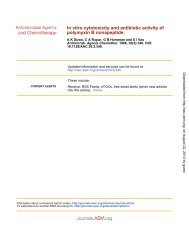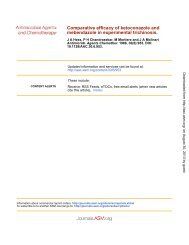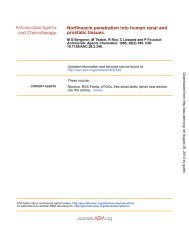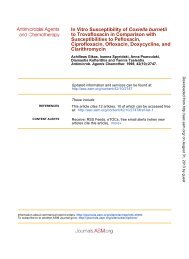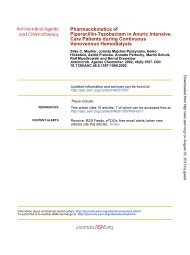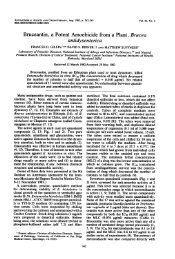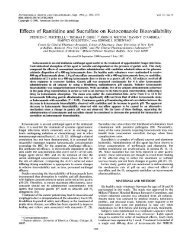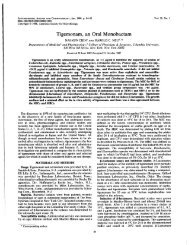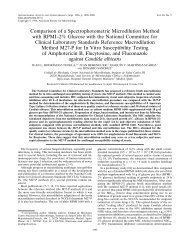Hydrophobic Antibiotics in Experimental Gram-Negative Infections in ...
Hydrophobic Antibiotics in Experimental Gram-Negative Infections in ...
Hydrophobic Antibiotics in Experimental Gram-Negative Infections in ...
Create successful ePaper yourself
Turn your PDF publications into a flip-book with our unique Google optimized e-Paper software.
Antibacterial synergism of polymyx<strong>in</strong> B<br />
nonapeptide and hydrophobic antibiotics <strong>in</strong><br />
experimental gram-negative <strong>in</strong>fections <strong>in</strong> mice.<br />
I Ofek, S Cohen, R Rahmani, K Kabha, D Tamark<strong>in</strong>, Y Herzig and<br />
E Rub<strong>in</strong>ste<strong>in</strong><br />
Antimicrob. Agents Chemother. 1994, 38(2):374. DOI:<br />
10.1128/AAC.38.2.374.<br />
CONTENT ALERTS<br />
Updated <strong>in</strong>formation and services can be found at:<br />
http://aac.asm.org/content/38/2/374<br />
These <strong>in</strong>clude:<br />
Receive: RSS Feeds, eTOCs, free email alerts (when new articles<br />
cite this article), more»<br />
Downloaded from http://aac.asm.org/<br />
on August 23, 2013 by guest<br />
Information about commercial repr<strong>in</strong>t orders: http://journals.asm.org/site/misc/repr<strong>in</strong>ts.xhtml<br />
To subscribe to to another ASM Journal go to: http://journals.asm.org/site/subscriptions/
ANTIMICROBIAL AGENTS AND CHEMOTHERAPY, Feb. 1994, p. 374-377 Vol. 38, No. 2<br />
0066-4804/94/$04.00+0<br />
Copyright © 1994, American Society for Microbiology<br />
Antibacterial Synergism of Polymyx<strong>in</strong> B Nonapeptide and<br />
<strong>Hydrophobic</strong> <strong>Antibiotics</strong> <strong>in</strong> <strong>Experimental</strong> <strong>Gram</strong>-<strong>Negative</strong><br />
<strong>Infections</strong> <strong>in</strong> Mice<br />
ITZHAK OFEK,I* SOFIE COHEN,1 RITA RAHMANI,1 KISRA KABHA,' DOVE TAMARKIN,2<br />
YAACOV HERZIG,2 AND ETHAN RUBINSTEIN3<br />
Departments of Human Microbiology' and Medic<strong>in</strong>e,3 Sackler Faculty of Medic<strong>in</strong>e, Tel Aviv University,<br />
Tel Aviv 69978, and Teva Pharmaceutical Industries Ltd., Petach-Tikva 49131,2 Israel<br />
Received 10 May 1993/Returned for modification 20 July 1993/Accepted 3 November 1993<br />
Polymyx<strong>in</strong> B nonapeptide, derived by cleavage of the fatty acyl diam<strong>in</strong>obutyric acid from polymyx<strong>in</strong> B, is<br />
considerably less toxic, lacks bactericidal activity, and reta<strong>in</strong>s its ability to render gram-negative bacteria<br />
susceptible to several antibiotics by permeabiliz<strong>in</strong>g their outer membranes. The peptide rendered all 53<br />
polymyx<strong>in</strong>-susceptible stra<strong>in</strong>s tested more susceptible to novobioc<strong>in</strong>, lower<strong>in</strong>g the MIC of novobioc<strong>in</strong> eightfold<br />
or more. The comb<strong>in</strong>ation of polymyx<strong>in</strong> B nonapeptide with novobioc<strong>in</strong> or with erythromyc<strong>in</strong> adm<strong>in</strong>istered<br />
<strong>in</strong>traperitoneally <strong>in</strong> multiple doses synergistically protected mice <strong>in</strong>fected with gram-negative bacteria. This<br />
comb<strong>in</strong>ation may be cl<strong>in</strong>ically useful because of the apparent rarity of the acquisition of resistance.<br />
Resistance to hydrophobic antibiotics <strong>in</strong> gram-negative bacteria<br />
may be either due to a decrease <strong>in</strong> the penetration of the<br />
antibiotic through the outer membrane or due to specific<br />
mechanisms, such as gene mutation or acquisition of resistance<br />
genes. The dist<strong>in</strong>ction between the two types of resistance is<br />
important, because it allows the search for antibiotics to which<br />
the development of specific mechanisms of resistance are rare<br />
but to which the bacterial membrane is impermeable. Such<br />
active but nonpenetrat<strong>in</strong>g antibiotics may ga<strong>in</strong> cl<strong>in</strong>ical use<br />
when comb<strong>in</strong>ed with membrane-active agents that <strong>in</strong>crease<br />
their penetration. Polycations at sublethal concentrations <strong>in</strong>crease<br />
the permeability of the outer membranes of gramnegative<br />
bacteria and render these microorganisms susceptible<br />
to many hydrophobic antibiotics (15-18). Among the various<br />
polycations tested, polymyx<strong>in</strong> B nonapeptide (PMBN), derived<br />
by cleav<strong>in</strong>g the fatty acid moiety from polymyx<strong>in</strong> B, has been<br />
studied the most. PMBN lacks antibacterial activity but renders<br />
most polymyx<strong>in</strong>-susceptible gram-negative bacteria susceptible<br />
to hydrophobic antibiotics by disorganiz<strong>in</strong>g the bacterial<br />
outer membranes to enhance antibiotic penetration (17-<br />
19). In the present study, we sought to further determ<strong>in</strong>e the<br />
<strong>in</strong>cidence of stra<strong>in</strong>s that exhibit permeability-associated resistance<br />
<strong>in</strong> assays with PMBN and to exam<strong>in</strong>e the therapeutic<br />
efficacy of hydrophobic antibiotics <strong>in</strong> comb<strong>in</strong>ation with PMBN<br />
<strong>in</strong> experimental gram-negative <strong>in</strong>fections <strong>in</strong> mice.<br />
All cl<strong>in</strong>ical isolates were obta<strong>in</strong>ed from various body sites at<br />
regional outpatient cl<strong>in</strong>ics (see Table 2). The bacteria were<br />
grown on agar slants (nutrient agar; Difco Laboratories,<br />
Detroit, Mich.) and kept at 4°C for up to 2 weeks. The MICs<br />
of each antibiotic were determ<strong>in</strong>ed as described elsewhere (7).<br />
In brief, 10 ,ul of a bacterial suspension (approximately 105<br />
CFU) from an overnight culture <strong>in</strong> isotonic Sensitest broth<br />
(Oxoid) was <strong>in</strong>oculated <strong>in</strong>to microtiter plate wells each conta<strong>in</strong><strong>in</strong>g<br />
100 [lI of a serial twofold dilution of the test antibiotic(s)<br />
<strong>in</strong> broth. Each test was done <strong>in</strong> triplicate, and the MIC<br />
was def<strong>in</strong>ed as the concentration at which there was no visible<br />
growth. ICR female mice were <strong>in</strong>fected <strong>in</strong>traperitoneally with<br />
*<br />
Correspond<strong>in</strong>g author. Mail<strong>in</strong>g address: Department of Human<br />
Microbiology, Sackler Faculty of Medic<strong>in</strong>e, Tel Aviv University, Tel<br />
Aviv 69978, Israel. Phone: 972-3-6409059. Fax: 972-3-6409160.<br />
374<br />
0.5 ml of phosphate-buffered sal<strong>in</strong>e (0.1 M NaCl, 0.02 M P04;<br />
pH 7.2) conta<strong>in</strong><strong>in</strong>g either 5 x 105 CFU of Klebsiella pneumoniae<br />
serotype K2 (1) harvested from the logarithmic phase<br />
of growth <strong>in</strong> nutrient broth (Difco) at 37°C or 1 x 108 CFU of<br />
Pseudomonas aerug<strong>in</strong>osa 33347 (k<strong>in</strong>dly provided by Nehama<br />
Garber, Bar-Ilan University, Ramat-Gan, Israel) harvested<br />
from agar slants after overnight growth at 37°C (8).<br />
The efficacy of PMBN either alone or <strong>in</strong> comb<strong>in</strong>ation with<br />
other antibiotics was evaluated follow<strong>in</strong>g <strong>in</strong>traperitoneal adm<strong>in</strong>istration<br />
of 0.5 ml of water conta<strong>in</strong><strong>in</strong>g various amounts of<br />
the antibiotics to groups of 6 to 20 mice at the desired time<br />
<strong>in</strong>tervals after bacterial challenge. The number of dead mice<br />
was counted 1 week later. The 50% lethal doses of the bacteria<br />
<strong>in</strong> mice were determ<strong>in</strong>ed as described previously (10) to be 2<br />
x 105 and 5 x 107 CFU for K pneumoniae and P. aerug<strong>in</strong>osa,<br />
respectively.<br />
PMBN rendered all polymyx<strong>in</strong>-susceptible stra<strong>in</strong>s susceptible<br />
to six different antibiotics tested, except for one P. aerug<strong>in</strong>osa<br />
stra<strong>in</strong> resistant to nafcill<strong>in</strong> and one Escherichia coli and<br />
two K pneumoniae stra<strong>in</strong>s resistant to vancomyc<strong>in</strong> (Table 1).<br />
These resistant stra<strong>in</strong>s probably possess mechanisms of resistance<br />
unrelated to permeability. This presumption is strengthened<br />
by the <strong>in</strong>ability of the deacylated peptide to lower the<br />
MIC of ampicill<strong>in</strong> aga<strong>in</strong>st three penicill<strong>in</strong>ase-produc<strong>in</strong>g stra<strong>in</strong>s.<br />
Further studies focused on the ability of PMBN to reduce<br />
the MIC of novobioc<strong>in</strong> for 55 cl<strong>in</strong>ical isolates belong<strong>in</strong>g to n<strong>in</strong>e<br />
bacterial species and exhibit<strong>in</strong>g multiple resistance patterns.<br />
PMBN caused a significant reduction <strong>in</strong> the MIC of novobioc<strong>in</strong><br />
for all 53 polymyx<strong>in</strong>-susceptible stra<strong>in</strong>s tested, <strong>in</strong>clud<strong>in</strong>g 7<br />
qu<strong>in</strong>olone-resistant stra<strong>in</strong>s (Table 2). The MIC of norfloxac<strong>in</strong><br />
for six qu<strong>in</strong>olone-resistant stra<strong>in</strong>s was 600 ptg/ml, and PMBN<br />
did not cause a significant reduction <strong>in</strong> this MIC (data not<br />
shown), suggest<strong>in</strong>g that resistance to qu<strong>in</strong>olones is probably<br />
due to mechanisms other than permeability. We conclude that<br />
resistance to novobioc<strong>in</strong> <strong>in</strong> gram-negative bacteria is probably<br />
solely due to the <strong>in</strong>ability of the antibiotic to penetrate the<br />
outer membrane. In a separate study, we found that 30 ,ug of<br />
PMBN per ml reduced the MIC of novobioc<strong>in</strong> for P. aerug<strong>in</strong>osa<br />
(blood isolate) from 250 to 0.05 and 0.1 ,ug/ml <strong>in</strong> the<br />
presence of 10 and 5% normal human serum, respectively.<br />
Previous studies showed that a s<strong>in</strong>gle <strong>in</strong>travenous adm<strong>in</strong>is-<br />
Downloaded from http://aac.asm.org/ on August 23, 2013 by guest
VOL. 38, 1994<br />
NOTES 375<br />
TABLE 1.<br />
Effect of PMBN on the MICs of antibiotics for 11 stra<strong>in</strong>s of gram-negative bacteria<br />
Presence of MIC<br />
Stra<strong>in</strong> O__:<br />
(,ug/ml)<br />
PMBN' at 30 Fg/ml Ampicill<strong>in</strong> Erythromyc<strong>in</strong> L<strong>in</strong>comyc<strong>in</strong> Nafcill<strong>in</strong> Novobioc<strong>in</strong> Vancomyc<strong>in</strong><br />
Escherichia coli<br />
EC1 - > 1,000 32 256 > 1,000 256 128<br />
+ >1,000 1 2 128 0.1 8<br />
EC2 - Ni 64 256 256 128 128<br />
+ NT 1 8 64 2 32<br />
EC3 - NT 32 NT >1,000 128 128<br />
+ NT 2 NT 256 8 64<br />
EC4 - NT 64 NT >1,000 128 128<br />
+ NT 2 NT 16 2 32<br />
Klebsiella pneumoniae<br />
KL1 - > 1,000 256 64 > 1,000 256 512<br />
+ >1,000 32 2 256 0.1 256<br />
KL2 - NT 256 > 1,000 > 1,000 256 256<br />
+ NT 16 2 256 16 256<br />
Pseudomonas aerug<strong>in</strong>osa<br />
PSi - >1,000 512 >1,000 >1,000 >1,000 >1,000<br />
+ 512 1 2 16 0.1 2<br />
PS2 - NT 16 >1,000 512 512 512<br />
+ NT 2 16 256 2 32<br />
PS3 - NT 512 > 1,000 > 1,000 > 1,000 > 1,000<br />
+ NT 0.5 64 64 8 0.1<br />
PS4 - NT NT NT >1,000 >1,000 512<br />
+ NT NT NT 1 2 16<br />
Salmonella typhimurium ST1 - NT 256 256 >1,000 512 256<br />
+ NT 16 4 128 4 64<br />
a<br />
PMBN was prepared by enzymatic deacylation of polymyx<strong>in</strong> B (Sigma Chemical Co., St. Louis, Mo.) as described previously (5, 18) with either fic<strong>in</strong> <strong>in</strong> buffer or<br />
papa<strong>in</strong> <strong>in</strong> distilled water. Identical results were obta<strong>in</strong>ed with PMBN prepared by hydrolysis with papa<strong>in</strong> <strong>in</strong> distilled water. Both procedures yielded identical batches<br />
of PMBN exhibit<strong>in</strong>g similar <strong>in</strong> vitro biological activities. The purity of the PMBN obta<strong>in</strong>ed by the two methods was ascerta<strong>in</strong>ed by high-pressure liquid-gas<br />
chromatography as described previously (9).<br />
b Antimicrobial powders for the determ<strong>in</strong>ation of MICs were provided by Bristol Myers Co., Wall<strong>in</strong>gford, Conn. (ampicill<strong>in</strong>); Abbott Laboratories, North Chicago,<br />
Ill. (erythromyc<strong>in</strong>); Upjohn s.a., Puurs, Belgium (l<strong>in</strong>comyc<strong>in</strong>); and Sigma (nafcill<strong>in</strong>, novobioc<strong>in</strong>, and vancomyc<strong>in</strong>). All stra<strong>in</strong>s tested for ampicill<strong>in</strong> susceptibility were<br />
penicill<strong>in</strong>ase producers, as assayed by methods described previously (13).<br />
c NT, not tested.<br />
TABLE 2.<br />
Organism (no. of isolates)'<br />
Effect of PMBN on the MIC of novobioc<strong>in</strong> for cl<strong>in</strong>ical isolates of gram-negative bacteriaa<br />
Test agent(s)<br />
MIC<br />
(pg/ml) % of isolates susceptible at breakpo<strong>in</strong>t<br />
Range 50%c concn (350 p.g of PMBN per ml. PMBN was prepared by hydrolysis with fic<strong>in</strong> as described previously (5, 18). PMBN was added at 30 ,ug/ml,<br />
except for Pseudomonas stra<strong>in</strong>s, for which it was added at 7.5 jig/ml.<br />
b The sources of the isolates were as follows: Ac<strong>in</strong>etobacter spp., six from ur<strong>in</strong>e and one from a wound; E. coli, four from departmental stock, eight from ur<strong>in</strong>e, and<br />
two from wounds; Enterobacter spp., four from blood, one from a wound, and one from sputum; K pneumoniae, five from ur<strong>in</strong>e, three from sputum, and two from<br />
wounds; P. mirabilis, two from ur<strong>in</strong>e; P. aerug<strong>in</strong>osa, n<strong>in</strong>e from ur<strong>in</strong>e, three from wounds, two from sputum, and one from blood; and S. typhimurium, one from<br />
departmental stock. With the exception of the two P. mirabilis isolates, all isolates were susceptible to polymyx<strong>in</strong> B. The antibiotic susceptibilities of the isolates were<br />
tested with Sensi-Discs (Becton Dick<strong>in</strong>son and Co., Rutherford, N.J.) accord<strong>in</strong>g to the manufacturer's <strong>in</strong>structions as described elsewhere (2) and accord<strong>in</strong>g to the<br />
guidel<strong>in</strong>es of the National Committee for Cl<strong>in</strong>ical Laboratory Standards for classify<strong>in</strong>g isolates as susceptible or resistant (12). All isolates were resistant to cl<strong>in</strong>damyc<strong>in</strong>,<br />
erythromyc<strong>in</strong>, nafcill<strong>in</strong>, rifamp<strong>in</strong>, and vancomyc<strong>in</strong>. A total of 5 isolates of Ac<strong>in</strong>etobacter spp. and 2 isolates of P. aerug<strong>in</strong>osa were resistant to at least three of the<br />
antibiotics listed below, 13 were resistant to only two, and 6 were resistant to none: ampicill<strong>in</strong>, chloramphenicol, cefotaxime, carbenicill<strong>in</strong>, gentamic<strong>in</strong>, kanamyc<strong>in</strong>,<br />
nalidixic acid, norfloxac<strong>in</strong>, streptomyc<strong>in</strong>, tetracycl<strong>in</strong>e, and tobramyc<strong>in</strong>.<br />
50%, MIC for 50% of isolates tested.<br />
Downloaded from http://aac.asm.org/ on August 23, 2013 by guest
376 NOTES<br />
ANTIMICROB. AGENTS CHEMOTHER.<br />
TABLE 3.<br />
Protection by PMBN, novobioc<strong>in</strong>, and erythromyc<strong>in</strong> of mice aga<strong>in</strong>st a challenge with P. aerug<strong>in</strong>osa or K pneumoniae<br />
Amount (mg/kg) of <strong>in</strong>traperitoneal drug adm<strong>in</strong>istration<br />
No. of surviv<strong>in</strong>g mice/total no.<br />
Antibiotic at <strong>in</strong>dicated time after challenge: challenged with:<br />
4 h 1 day 2 days K pneumoniae P. aerug<strong>in</strong>osa<br />
None 0/6 0/10<br />
PMBNa 50 50 NT 0/6<br />
Novobioc<strong>in</strong> 25 25 NT 0/8<br />
Novobioc<strong>in</strong> + PMBN 25 + 50 NT 0/6<br />
Novobioc<strong>in</strong> + PMBN 25 + 50 25 + 50 NT 10/10<br />
PMBN 4 2c 2 0/6 NT<br />
Erythromyc<strong>in</strong> 10 10c 10 0/18 NT<br />
Erythromyc<strong>in</strong> + PMBN 10 + 4 0/6 NT<br />
Erythromyc<strong>in</strong> + PMBN 10 + 4 10 + 2C 10 + 2 10/18 NT<br />
a b PMBN was prepared by hydrolysis of polymyx<strong>in</strong> B with papa<strong>in</strong> (see Table 1, footnote a).<br />
NT, not tested.<br />
c The amounts <strong>in</strong>dicated were adm<strong>in</strong>istered twice on day 1 after challenge.<br />
tration of PMBN (200 mg/kg of body weight) <strong>in</strong> comb<strong>in</strong>ation<br />
with erythromyc<strong>in</strong> to mice shortly after a challenge with a<br />
lethal dose of P. aerug<strong>in</strong>osa or E. coli failed to protect the<br />
animals (11). We used P. aerug<strong>in</strong>osa and K pneumoniae stra<strong>in</strong>s<br />
which were resistant to >1,000 ,ug of novobioc<strong>in</strong> per ml and<br />
>200 ,ug of erythromyc<strong>in</strong> per ml, respectively. The addition of<br />
PMBN to the medium rendered the stra<strong>in</strong>s susceptible to
VOL. 38, 1994 NOTES 377<br />
Performance standards for antimicrobial disk susceptibility tests.<br />
Publication M2-A3. National Committee for Cl<strong>in</strong>ical Laboratory<br />
Standards, Villanova, Pa.<br />
13. Rosenblatt, J. A., and A. M. Neman. 1978. A rapid slide test for<br />
penicill<strong>in</strong>ase. Am J. Cl<strong>in</strong>. Pathol. 69:551-554.<br />
14. Soogard, H. 1982. The pharmacodynamics of polymyx<strong>in</strong> antibiotics<br />
with special reference to drug resistance liability. J. Vet. Pharmacol.<br />
Ther. 5:219-231.<br />
15. Vaara, M. 1992. Agents that <strong>in</strong>crease the permeability of the outer<br />
membrane. Microbiol. Rev. 56:395-411.<br />
16. Vaara, M., and T. Vaara. 1983. Sensitization of gram-negative<br />
bacteria to antibiotics and complement by nontoxic oligopeptide.<br />
Nature (London) 303:526-528.<br />
17. Vaara, M., and T. Vaara. 1983. Polycations sensitize enteric bacteria<br />
to antibiotics. Antimicrob. Agents Chemother. 24:107-113.<br />
18. Vaara, M., and T. Vaara. 1983. Polycations as outer membranedisorganiz<strong>in</strong>g<br />
agents. Antimicrob. Agents Chemother. 24:114-122.<br />
19. Viljanen, P., and M. Vaara. 1984. Susceptibility of gram-negative<br />
bacteria to polymyx<strong>in</strong> B nonapeptide. Antimicrob. Agents Chemother.<br />
25:701-705.<br />
Downloaded from http://aac.asm.org/ on August 23, 2013 by guest




